
Nancy Drew is a fictional character, a sleuth in an American mystery series created by publisher Edward Stratemeyer as the female counterpart to his Hardy Boys series. The character first appeared in 1930. The books are ghostwritten by a number of authors and published under the collective pseudonym Carolyn Keene. Over the decades, the character evolved in response to changes in US culture and tastes. The books were extensively revised and shortened, beginning in 1959, in part to lower printing costs with arguable success. In the revision process, the heroine's original character was changed to be less unruly and violent. In the 1980s, an older and more professional Nancy emerged in a new series, The Nancy Drew Files, that included romantic subplots for the sleuth. The original Nancy Drew Mystery Stories series started in 1930 and ended in 2003. Launched in 2004, the Girl Detective series features Nancy driving a hybrid electric vehicle and using a cell phone. In 2012, the Girl Detective series ended, and a new series, Nancy Drew Diaries, was launched in 2013. Illustrations of the character evolved over time to reflect contemporary styles. The character proves continuously popular worldwide: at least 80 million copies of the books have been sold, and the books have been translated into over 45 languages. Nancy Drew is featured in five films, three television shows, and a number of popular computer games; she also appears in a variety of merchandise sold around the world.

Mildred Augustine Wirt Benson was an American journalist and author of children's books. She wrote some of the earliest Nancy Drew mysteries and created the detective's adventurous personality. Benson wrote under the Stratemeyer Syndicate pen name, Carolyn Keene, from 1929 to 1947 and contributed to 23 of the first 30 Nancy Drew mysteries, which were bestsellers.
Carolyn Keene is the pseudonym of the authors of the Nancy Drew mystery stories and The Dana Girls mystery stories, both produced by the Stratemeyer Syndicate. In addition, the Keene pen name is credited with the Nancy Drew spin-off, River Heights, and the Nancy Drew Notebooks.
The Stratemeyer Syndicate was a publishing company that produced a number of mystery book series for children, including Nancy Drew, the Hardy Boys, the various Tom Swift series, the Bobbsey Twins, the Rover Boys, and others. They published and contracted the many pseudonymous authors doing the writing of the series from 1899 through 1987, when the syndicate partners sold the company to Simon & Schuster.

The Bungalow Mystery is the third volume in the Nancy Drew Mystery Stories series written under the pseudonym Carolyn Keene. It was the last of three books in the "breeder set" trilogy, released in 1930, to test-market the series.
The Dana Girls was a series of young adult mystery novels produced by the Stratemeyer Syndicate. The title heroines, Jean and Louise Dana, are teenage sisters and amateur detectives who solve mysteries while at boarding school. The series was created in 1934 in an attempt to capitalize on the popularity of both the Nancy Drew Mystery Stories and the Hardy Boys series, but was less successful than either. The series was written by a number of ghostwriters and, despite going out-of-print twice, lasted from 1934 to 1979; the books have also been translated into a number of other languages. While subject to less critical attention than either Nancy Drew or the Hardy Boys, a number of critics have written about the series, most arguing that the Dana Girls' relative lack of success was due to the more dated nature of the series.

The Hardy Boys, brothers Frank and Joe Hardy, are fictional characters who appear in several mystery series for children and teens. The series revolves around teenagers who are amateur sleuths, solving cases that stumped their adult counterparts. The characters were created by American writer Edward Stratemeyer, the founder of book-packaging firm Stratemeyer Syndicate. The books themselves were written by several ghostwriters under the collective pseudonym Franklin W. Dixon.

Harriet Stratemeyer Adams was an American juvenile book packager, children's novelist, and publisher who was responsible for some 200 books over her literary career. She wrote the plot outlines for many books in the Nancy Drew series, using characters invented by her father, Edward Stratemeyer. Adams also oversaw other ghostwriters who wrote for these and many other series as a part of the Stratemeyer Syndicate, and rewrote many of the novels to update them starting in the late 1950s.
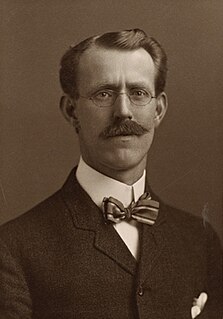
Edward L. Stratemeyer was an American publisher, writer of children's fiction, and founder of the Stratemeyer Syndicate. He was one of the most prolific writers in the world, producing in excess of 1,300 books himself, selling in excess of 500 million copies. He also created many well-known fictional book series for juveniles, including The Rover Boys, The Bobbsey Twins, Tom Swift, The Hardy Boys, and Nancy Drew series, many of which sold millions of copies and are still in publication today. On Stratemeyer's legacy, Fortune wrote: "As oil had its Rockefeller, literature had its Stratemeyer."

The Mystery At Lilac Inn is the fourth volume in the Nancy Drew Mystery Stories series. It was first published in 1930 under the pseudonym Carolyn Keene. Mildred Wirt Benson was the ghostwriter for the 1930 edition.
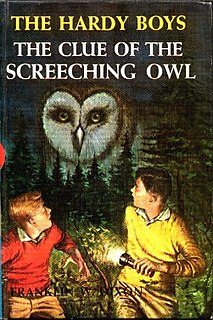
The Clue of the Screeching Owl is Volume 41 in the original The Hardy Boys Mystery Stories published by Grosset & Dunlap.

The Ringmaster's Secret is the thirty-first volume in the Nancy Drew Mystery Stories series. It was first published in late 1953 under the pseudonym Carolyn Keene. The actual author was ghostwriter Harriet Stratemeyer Adams.

The Hidden Window Mystery is the thirty-fourth volume in the Nancy Drew Mystery Stories series. It was first published in 1956 under the pseudonym Carolyn Keene. The actual author was ghostwriter Harriet Stratemeyer Adams.
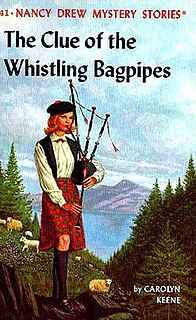
The Clue of the Whistling Bagpipes is the forty-first volume in the Nancy Drew Mystery Stories series. It was first published in 1964 under the pseudonym Carolyn Keene. The actual author was ghostwriter Harriet Stratemeyer Adams.

The Phantom of Pine Hill is the forty-second volume in the Nancy Drew Mystery Stories series. It was first published in 1965 under the pseudonym Carolyn Keene. The actual author was ghostwriter Harriet Stratemeyer Adams.
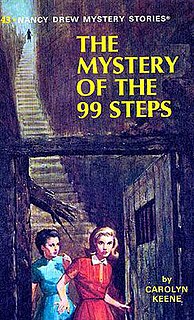
The Mystery of the 99 Steps is the forty-third volume in the Nancy Drew Mystery Stories series. It was first published in 1966 under the pseudonym Carolyn Keene. The actual author was ghostwriter Harriet Stratemeyer Adams.
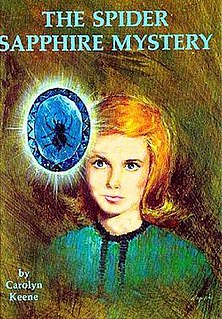
The Spider Sapphire Mystery is the forty-fifth volume in the Nancy Drew Mystery Stories series. It was first published in 1968 under the pseudonym Carolyn Keene. The actual author was ghostwriter Harriet Stratemeyer Adams.
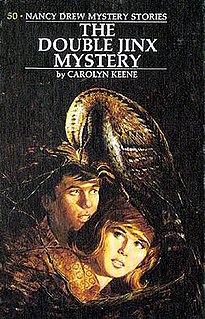
The Double Jinx Mystery is the fiftieth volume in the Nancy Drew Mystery Stories series. It was first published in 1973 under the pseudonym Carolyn Keene. The actual author was ghostwriter Harriet Stratemeyer Adams.

The Sky Phantom is the fifty-third volume in the Nancy Drew Mystery Stories series. It was first published in 1976 under the pseudonym Carolyn Keene. The actual author was ghostwriter Harriet Stratemeyer Adams.
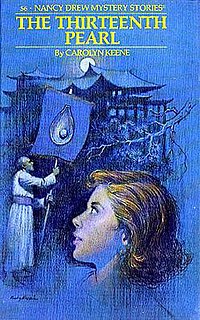
The Thirteenth Pearl is the fifty-sixth volume in the Nancy Drew Mystery Stories series. It was first published in 1979 under the pseudonym Carolyn Keene. The actual author was ghostwriter Harriet Stratemeyer Adams. The Thirteenth Pearl is the end of the original 56-book series published by Grosset & Dunlap. Subsequent volumes were published by Simon & Schuster.

















